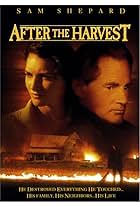Aggiungi una trama nella tua linguaA look at the life of the thoroughbred filly that dominated horse racing in the early 1970s.A look at the life of the thoroughbred filly that dominated horse racing in the early 1970s.A look at the life of the thoroughbred filly that dominated horse racing in the early 1970s.
- Premi
- 4 candidature totali
Foto
Recensioni in evidenza
I was and never have been an avid horse race watcher,but when I was ten years old,while looking for something to watch on television,I stumbled across a race consisting of two horses,one of which was named Ruffian.I remember the name because of the tragic event that took place and recall very little else about it.I remember Ruffian being badly injured and eventually having to be put down.I remember thinking how sad this was,and over the years,having heard next to nothing about it,have recalled it from time to time over the next thirty or so years.When I saw that a movie was made about her and that tragic day,I had to see it.Details that had been vague to me were brought to light.If the story told here was accurate,this was obviously a much loved,very majestic animal destined for greatness.To think that her life was cut short by some insignificant,over-hyped battle of the sexes mishmash is not only sad,it's infuriating.If anything good has come from that day,it's that challenge races no longer exist,thank goodness.
As an avid fan of Thoroughbred horse racing, and someone who followed Ruffian's career including witnessing her final race, I was pleasantly surprised by this made-for-TV film. Earlier in the day, the ABC network broadcast the Belmont Stakes in which viewers saw the unique character befitting many of the long-time sportswriters who cover Thoroughbred racing. Unfortunately for the film, Frank Whaley failed to deliver that persona in the key role of sportswriter Bill Nack. However, Sam Shepard in the starring role of trainer Frank Whiteley gave a most believable performance, capturing the real life trainer's restrained professionalism. While the film's setup for the Sorority Stakes was good, I would like to have seen more background as a lead into each of the races depicted. The writers capably demonstrated how the horse, even against the wishes of its trainer, was secondary to "filling the stands" for the moguls of the racing industry. To his credit, French-Canadian director Yves Simoneau did not overly dramatize the horse's final moments, instead, effectively borrowing the eye/lash closeup created by Krzysztof Kieslowski in his French-language film, "Trois couleurs: Bleu"
Overall this is a good film about a great horse, Ruffian. It presented a time capsule of the racing world in 1974-75. One theme was that racing needed a great horse to draw crowds and the tracks (the New York tracks particularly) were empty due to lack of interest. This isn't entirely true. Secretariat raced in 1972-73 and he was in the first running of the Marlboro Cup which attracted champion horses. And the Marlboro Cup which was a pre Breeders Cup race attracted huge crowds. The film implies that Ruffian got more people to the empty track. Not entirely true--she most likely attracted new fans but the fans packed the stands for the Big races like the Belmont Stakes and Marlboro Cup. Also, Foolish Pleasure is raised to War Admiral like quality in the run through to the match race. However, Foolish Pleasure was not THE standout three year old colt of 1975--it was actually Wajima who became Champion three year old colt of that year. Foolish Pleasure was a nice racehorse but nowhere near this superhorse the movie implied he was.
Also, there was a painfully long sequence of the run on the backstretch where Ruffian broke down (run in slow motion showing the leg actually snapping in close up). I think perhaps just running the actual race would have been shown to better effect.
Sam Shepard did an excellent job as Ruffian's trainer Frank Whitely. The actors playing the owners were given rather unsympathetic parts particularly when they pushed for the match race. The film also had an interesting angle of the viewpoint of the Newsday reporter who followed the career of the great filly.
The sequences of the real Ruffian in the closing credits were refreshing to watch. More scenes of her races (not the simulated ones) would have been welcome.
Also, there was a painfully long sequence of the run on the backstretch where Ruffian broke down (run in slow motion showing the leg actually snapping in close up). I think perhaps just running the actual race would have been shown to better effect.
Sam Shepard did an excellent job as Ruffian's trainer Frank Whitely. The actors playing the owners were given rather unsympathetic parts particularly when they pushed for the match race. The film also had an interesting angle of the viewpoint of the Newsday reporter who followed the career of the great filly.
The sequences of the real Ruffian in the closing credits were refreshing to watch. More scenes of her races (not the simulated ones) would have been welcome.
I had just gotten interested in the Triple Crown races for colts when the famous "Battle of the Sexes" aired, and I do remember what happened to Ruffian. If you are not familiar with the story, I won't give away the ending, but the events in the last few minutes of this movie may be upsetting to some people.
Sam Shepard did an outstanding job as the horse's trainer. Some of his reactions were not what I expected, but since the characters in this movie were supposedly real, perhaps he really did what was depicted. In that case, Frank Whiteley was an amazing man. He cared about his horses and about doing the right thing, but at some point he had to say yes, it's terrible, but life goes on.
Frank Whaley did a very good job as a leading sports reporter. His personality didn't appeal to me personally, but he was quite a character. Vladimir Diaz did well as Jacinto Vasquez, the jockey who rode Ruffian on several occasions, a man depicted as having high moral standards despite all that was happening.
The track announcers were excellent. And most of the leading actors gave good performances.
The horse action was well done. We saw numerous unusual camera angles of the races. Every win by Ruffian was shown in slow motion.
I liked the joke played on the reporters at Ruffian's stall. All this hype was seen as ridiculous by certain characters, as well it should have been. And this was 30 years before Paris Hilton!
Effective use was made of what appeared to be real footage of fans of both Ruffian and Foolish Pleasure as horse racing's answer to Billie Jean King vs. Bobby Riggs approached. And of course extras wore the t-shirts and cheered for their horse. This all drove home the point that this event was kind of silly. Several times it was suggested Ruffian could have just competed against the guys--Rags to Riches did just that the day I saw this--but if that never happened, then it couldn't have been in the movie.
Displayed on the screen was a reminder that some events in the movie were fictional. Included among these was the specific event--shown in slow motion--that may have caused what I'm not giving away. Also shown on screen at the movie's end was the fact that no one really knows WHAT happened.
The only weakness I saw was the fact that Ruffian's early career was rushed. The big event in her life was given so much time that the only way to adequately show her progress would have been to make this a three-hour movie (commercials included) rather than two. Perhaps two and a half would have been enough.
But for the time allotted, this was a fine effort.
Sam Shepard did an outstanding job as the horse's trainer. Some of his reactions were not what I expected, but since the characters in this movie were supposedly real, perhaps he really did what was depicted. In that case, Frank Whiteley was an amazing man. He cared about his horses and about doing the right thing, but at some point he had to say yes, it's terrible, but life goes on.
Frank Whaley did a very good job as a leading sports reporter. His personality didn't appeal to me personally, but he was quite a character. Vladimir Diaz did well as Jacinto Vasquez, the jockey who rode Ruffian on several occasions, a man depicted as having high moral standards despite all that was happening.
The track announcers were excellent. And most of the leading actors gave good performances.
The horse action was well done. We saw numerous unusual camera angles of the races. Every win by Ruffian was shown in slow motion.
I liked the joke played on the reporters at Ruffian's stall. All this hype was seen as ridiculous by certain characters, as well it should have been. And this was 30 years before Paris Hilton!
Effective use was made of what appeared to be real footage of fans of both Ruffian and Foolish Pleasure as horse racing's answer to Billie Jean King vs. Bobby Riggs approached. And of course extras wore the t-shirts and cheered for their horse. This all drove home the point that this event was kind of silly. Several times it was suggested Ruffian could have just competed against the guys--Rags to Riches did just that the day I saw this--but if that never happened, then it couldn't have been in the movie.
Displayed on the screen was a reminder that some events in the movie were fictional. Included among these was the specific event--shown in slow motion--that may have caused what I'm not giving away. Also shown on screen at the movie's end was the fact that no one really knows WHAT happened.
The only weakness I saw was the fact that Ruffian's early career was rushed. The big event in her life was given so much time that the only way to adequately show her progress would have been to make this a three-hour movie (commercials included) rather than two. Perhaps two and a half would have been enough.
But for the time allotted, this was a fine effort.
The 1970s were the height of the battle of the sexes. Men and women were in open combat, anywhere and everywhere: tennis (Riggs vs. King), the voting booth (ERA), and, on July 6, 1975, Belmont Park, when the undefeated Ruffian was sent off at 1-20 odds (you had to lay 20-1 odds on her) to defeat the Kentucky Derby winner, Foolish Pleasure, mediocre in comparison to Ruffian.
Period pieces are not easy to shoot, since they are done from memory and historical records. I was alive and following the New York tracks as a youth, and became aware of Ruffian in the spring of 1975, after she had blazed her way onto the front pages as a legitimate Kentucky Derby threat. Today, she would have run for the roses without a second thought, but her owners were old-school and gave it not a second thought.
This film captures the phenomenon that was Ruffian, from promising ace-in-the-barn that her trainer knew would win her debut at 4-1, but not by 15 lengths in 1:09. No matter how good they look in training, you never know what's going to happen when they actually run. Ruffian answered every question asked of her, even winning when slightly injured, finding the heart to put away her strong-but-weaker peers.
Ruffian was a freight train, and while the details of the film were glossed over, this was a TV film and that is often the case. Watch "Babe Ruth" from 1991 (TV) and "The Babe" from 1992 (Feature Film) for simimlar disparity. Indeed, you could also read the "Seabiscuit" book from 1997, and find it much richer than its paperback predecessor, "Come On, Seabiscuit!" from 1975.
This was the discount version of the Ruffian story. The big-budget treatment she may one day get awaits.
Ruffian was the first horse ever buried in the infield at Belmont Park. That is how special she was. She died of a broken leg because horses like her cannot live even long enough to recover on one, as they are simply born to run, her like no other.
Period pieces are not easy to shoot, since they are done from memory and historical records. I was alive and following the New York tracks as a youth, and became aware of Ruffian in the spring of 1975, after she had blazed her way onto the front pages as a legitimate Kentucky Derby threat. Today, she would have run for the roses without a second thought, but her owners were old-school and gave it not a second thought.
This film captures the phenomenon that was Ruffian, from promising ace-in-the-barn that her trainer knew would win her debut at 4-1, but not by 15 lengths in 1:09. No matter how good they look in training, you never know what's going to happen when they actually run. Ruffian answered every question asked of her, even winning when slightly injured, finding the heart to put away her strong-but-weaker peers.
Ruffian was a freight train, and while the details of the film were glossed over, this was a TV film and that is often the case. Watch "Babe Ruth" from 1991 (TV) and "The Babe" from 1992 (Feature Film) for simimlar disparity. Indeed, you could also read the "Seabiscuit" book from 1997, and find it much richer than its paperback predecessor, "Come On, Seabiscuit!" from 1975.
This was the discount version of the Ruffian story. The big-budget treatment she may one day get awaits.
Ruffian was the first horse ever buried in the infield at Belmont Park. That is how special she was. She died of a broken leg because horses like her cannot live even long enough to recover on one, as they are simply born to run, her like no other.
Trama
Lo sapevi?
- QuizBecause Ruffian was such a large filly, larger even than many colts (including Foolish Pleasure), they used geldings to portray her in the film.
- BlooperIn certain camera angles, it can be seen that the horses playing Ruffian are actually male ( geldings) and not fillies.
- ConnessioniFeatured in 14th Annual Screen Actors Guild Awards (2008)
I più visti
Accedi per valutare e creare un elenco di titoli salvati per ottenere consigli personalizzati
Dettagli
- Data di uscita
- Paese di origine
- Lingua
- Celebre anche come
- Ruffian, a csodakanca
- Luoghi delle riprese
- Aziende produttrici
- Vedi altri crediti dell’azienda su IMDbPro
Contribuisci a questa pagina
Suggerisci una modifica o aggiungi i contenuti mancanti

























